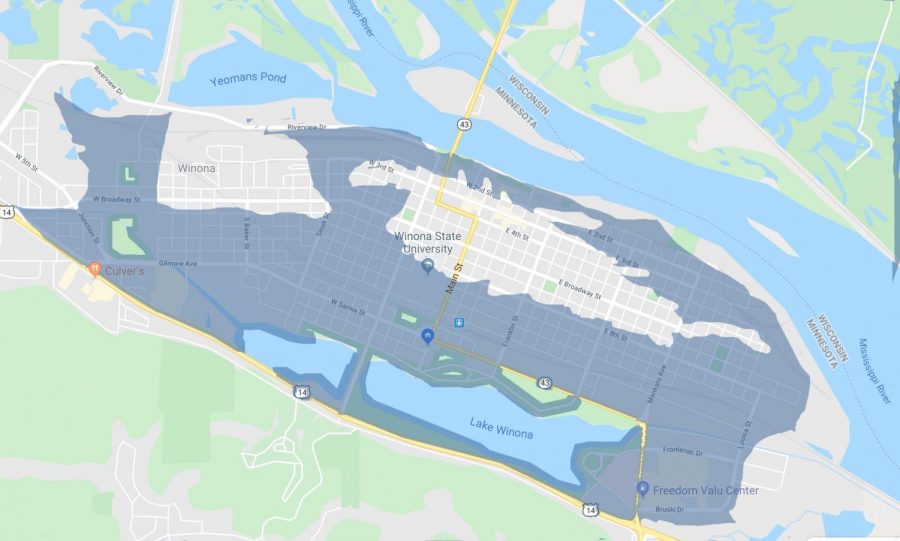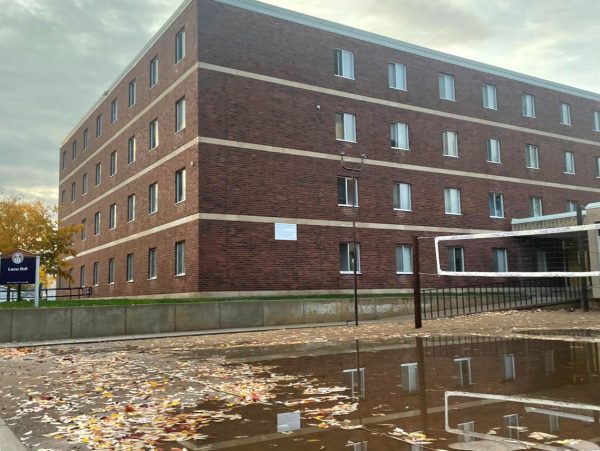River flooding on the rise for the Mississippi
As of 2018 the highlighted areas are within the 100-year floodplain if not for the Winona levee systems. Throughout the fall of 2018 Winona experienced the sixth highest amounts of rainfall since 1939, leaving many concerned about the increased risk of flooding. The photo illustration is based of FEMA maps.
November 13, 2019
Winona’s bouts of flooding and flood warnings in the last few years may be hints to a much larger climate and environment issue.
Fall of 2018 experienced exceptional rainfall and late-season tornado warnings in particular.
CBS Minnesota found that 2018 rainfall totaled to the sixth-highest amount in Winona since 1939. Meteorologists on Sept. 20 announced further flash flood warnings. By the end of the month, rainfall had totaled three to eight inches above average across southern Minnesota, according to CBS Minnesota.
In total, 2018 set a statewide yearly record for rainfall in Minnesota, with more than 41 inches of precipitation.
Winona’s total precipitation fell just below that record at 40.95 inches, according to the CBS weather service provider.
This past summer, storms caused wind damage and flooding, leaving southeast Minnesota and parts of west Wisconsin “more than three feet over flood stage,” according to Winona Daily News. Altogether, many experts believe these weather events, among others, may be the consequences of a changing climate and environment.
According to Dr. Michael Delong, a biology professor specializing in ecology of large rivers at Winona State University, it is assuredly so.
“Since 2010 we’ve had this high degree of variability which is unusual for a river in this part of the country,” Delong said.
Delong explained that a notable amount of variability has been evident since the mid-2000s, which had odd drought periods, while the time between 2007 and 2009 again saw especially low river levels after spikes of rain.
“There are a number of factors that are involved in that [flooding],” Delong said. “The first one we can assign is climate change, that is without a doubt a cause of this.”
However, factors that account to the flooding in Winona dive deeper than just ‘climate change’.
Since the city of Winona’s founding in 1854, much of its environment and population has changed. Winona rapidly grew in the 19 century due to the railway and steamboat transportation systems, the lumber industry and establishment of the first normal school west of the Mississippi.
Urbanization has been a key factor in varying weather patterns, including changing river and flood levels in Winona.
Delong explained that the hard surfaces brought in by urbanization – parking lots, streets built in the community, etc. – don’t allow water to penetrate into soil, but rather force it to run back into the river, adding to river levels.
Agriculturally, streams and parts of the river have been manually straightened out, creating ditches, which continue to be filled by tilling, a common farming practice.
“There’s heavy tilling where there used to be wetland, rivers and lakes,” Delong said referring to the Winona area. “Something like 90% of these areas are agriculture land now.”
These factors in river levels and flooding also hurt the city culturally and economically.
Delong noted that navigation was shut down for a portion of this past summer due to the high river level. By the time the river level began to lower, there was a scramble to catch up in grain and other product movement along the river, which hurt Winona’s economy.
It is not just in Winona and southeast Minnesota that have experienced varied changes, but also other areas near the lower portion of the Mississippi river.
According to Delong, there was flooding in Ohio due to the rise in the Mississippi River this year.
River level changes like those that have occurred since the mid-2000s in Winona hurt the very makeup of its river wildlife.
While animals can adapt to their environments, they are not able to continue to bounce back and forth to keep up with such variability.
Delong explained that for instance, a rising or lowering of the river level changes its temperature, this tampering with the mating process and success of fish and aquatic life.
Fishing is a major attraction and hobby of those in the Winona area due to the availability of the Mississippi River, but unfortunately, biological integrity has often come second to economic management of the river and life.
Following a major 2007 flood in Winona, professor Neal Mundahl of Winona State University, and Ashley Hunt collected data on freshwater ecology in southeast Minnesota, including the recovery of river wildlife after the flooding.
Mundahl and Hunt’s study, published in the Journal of Freshwater Ecology (2011), found that assemblages of invertebrates were 75% lower than expected based on populations found in previous years following floods.
While 20 months later, some population densities were gradually increasing and recovering, others were not.
“Despite these increases, average invertebrate densities generally remained below pre-flood summer levels even 22 months after flooding,” Mundahl said.
The environmental factors to the flooding are often overlooked. High levels of precipitation and varied river levels are indicators of varied and off-kilter climate, pointing towards climate change.
“There is, of course, still a degree of uncertainty,” Delong said of the climate change effects in Winona. “But there’s no doubt it’s happening. There’s no argument.”




































































